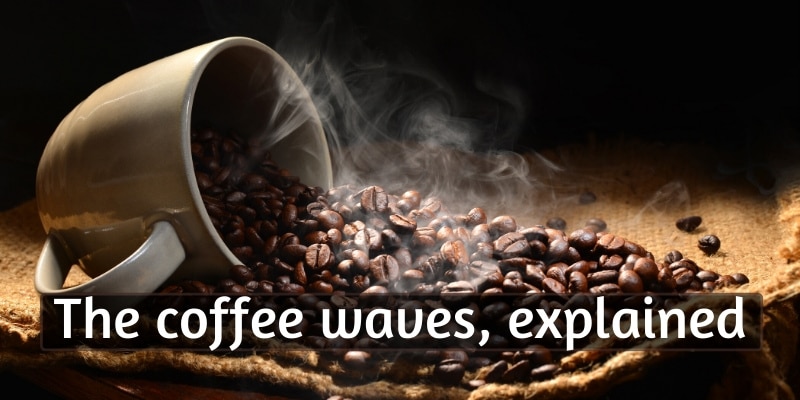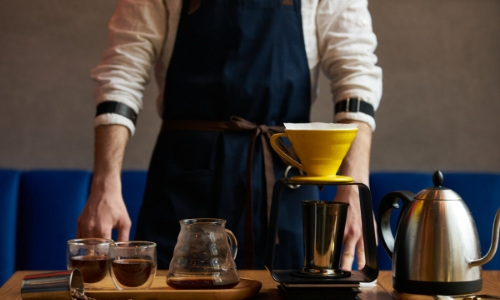The coffee world has seen a lot of trends through history. Yet in the past few decades the coffee world is passing through a period of growth and progression.
And this is a good sign for coffee lovers. The more people are concerned about the quality, the more this industry will grow.
In this article, we'll talk about the transition from the first wave of coffee to the third wave. This third wave is happening right now and it's almost got its foot into the fourth wave. So let's see them.
Table of Contents
What are coffee waves ?
All of these coffee waves have to do with some main factors that affected the coffee industry over time. Some of them are about the quality of coffee beans, quality of farmers, sourcing practices, education, and so on.
You will notice in each wave how each factor is influenced, and how the waves can give you a much better understanding of coffee.
The first wave was a big influence on the second, and the third came as a reaction and improvement on the second so they're all very connected.
Let's clarify that we're talking about the last century when coffee begins to be part of a life routine. Coffee was available long before this but it wasn't an everyday staple like it is today, it was more of an upper class thing.
Secondly, all of these waves still exist today, at the same time.
Some companies are still in the first wave.
At the same time, other companies are in the third wave.
And this is the most valuable thing for the customers. More and more consumers are aware of what's going on in the coffee industry and decide to help in whatever way they can, thus subscribing to a coffee wave (usually the third one).
Let's discuss each wave in particular so we understand them better.
First-wave coffee
This particular wave is the start of a progression, but it will remain at the lowest quality. It is well known for the commodity and the lack of transparency.
Most of the companies in this wave don't focus on the quality of coffee. They don't deliver information like the origin of coffee or any information about beans.
Their focus is to convince people that their coffee comes from a factory, not from a farm or a real plant. This is why a lot of people thought and still think that coffee is not even a real plant.
There's a big lack of information in the first wave, and it shows. Some of the main aspects this bleeds into is how poorly coffee farmers are treated, the preference for sun grown coffee vs shade grown, the rise of Robusta or mixed coffee, and so on.
It's a more quantity and profit vs quality and wages for workers.
How to identify a cup of coffee from the first wave:
- Super dark, bitter coffee with a lot of oil on the surface of beans.
- There is no information about the origin of coffee beans and usually they are blended, as in from multiple unspecified origins.
- Language like "premium", "gourmet", "the best", "naturally".
- Some coffee beans could be freeze-dried and vacuum-sealed.
- Ready-to-use products and often pre-grounded coffee with no proper instruction for what kind of method it's supposed for.
- Artificial flavors.
- Usually you can find it in the supermarket, almost always includes store-brand coffee.
- Fairly cheap, even the gourmet and premium labels.
Second wave coffee
Now we can take a step forward and talk about some improvements.
The companies begin to think more about the quality of coffee and the customer experience. This is the time when coffee shops start to actively change the coffee industry and try to show people that coffee is more than a simple dark drink.
Although this can be called an improvement, the idea of communicating the roots of the beans is still rare. Their focus is more about mixing the first wave with some new concepts.
In this wave, Starbucks is a great example. They try to introduce people to the idea of a 'coffee journey' and mixing the coffee from the first wave with a lot of artificial flavors to create complex drinks.
It's also when latte art became very popular, and serving coffee turned into more of a skill and art than a job. Not as much as it is today but this was the first step.
Here's how to identify a coffee from the second wave:
- Limited information about the origin of coffee. Some companies can provide just the country of origin, but that's it. Nothing about the origin region, the farmers, the processing, the coffee plant.
- Still dark coffee with a bitter and harsh taste. This is why covering the bitter with artificial flavors seemed to be an improvement.
- Still blended coffee from various origins, never stated in what proportions.
- Passionate baristas about coffee preparation, but not about the taste. These baristas also exist today, and most of them work in companies that provide coffee from the first wave.
Everything ties together and you'll find that each wave has a heavy influence on the following wave, very much like fashion.
Third-wave coffee
From now on, we can talk about more and more improvements. This particular wave started in the 1980s from the initiative of a small group of coffee shops owner and roasteries.
Their focus was to communicate more and more with farmers and to roast lighter and lighter. They assume that coffee can produce more extensive notes, aromas, and flavors.
In 1982 the Specialty Coffee Association was founded, and from this point on the coffee industry started to grow faster and faster from different points of view.
How to identify coffee from the third wave:
- Origin of coffee beans, farmers, and roasteries are clearly stated on the label.
- Medium and light roasting. The beans have a great brown color and smell good, not burnt.
- Single-origin. This is a huge improvement for the coffee industry. You can sense specific notes and aroma, and actually tell the difference between beans. You may find labels like "specific notes: nuts, citric, apple".
- More transparency. Third wave companies provide information like roast date, processing method, the name of the farmers, and sometimes the name of the roaster.
- Baristas are passionate about coffee, taste, latte art, and customer experience. They usually know everything about the coffee they serve.
- Language like "specialty coffee", "fresh roasted coffee".
- Brewing guides on the coffee packs themselves, sometimes.
- The rise of alternative brewing in general.
- Grind size and brew method recommendation on most coffee packs.
Notice that until now the words brew, roast, light roast and origin weren't really present. There was mush less emphasis on this and it showed in terms on coffee quality.
What about the fourth wave?
This is still unknown territory. Maybe we're closer than we think but it's still somewhere in the future. Some little companies aspire to make a difference in the coffee industry, and this is a great sign.
It's assumed that some of the improvements may be:
- Lighter roast, with more transparency. More direct trade without intermediaries between the farmers and the roaster.
- Increased access to a good education for the consumers.
- Focus on people and the coffee experience in the shops, as opposed to profit.
- Fairtrade. This implies that coffee farmers are paid fair wages for their work.
The list could be very different when the fourth wave actually comes, or it might just a have a couple of improvements. The point is that coffee is now more of an experience than a single product, and this means more attention to detail in production, serving, farming, roasting, brewing, etc.
Overall these are all great improvements and the fourth wave may bring something we can't even see in this moment.
So what do these three waves mean for you ?
Well, first of all, people can make different choices every day. They can consume coffee from any wave, and this is just great.
But, when we are adequately familiarized with all of these, we can make better choices. Knowing what is in our cup can be satisfying, and opting for something instead of landing on it because we didn't know any better is a big change.
I hope this article helps you make better decisions every day for a full coffee experience.
If you want to know more about coffee or tea, feel free to check the related articles below. Who knows what else you might find ?








